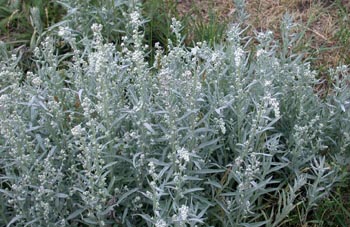Louisiana Sage

Common Name(s):
Louisiana Sage
Herbaceous sage
Cudweed sagewort
Wormwood
Scientific Name:
Artemisia ludoviciana Nutt.
Scientific Name Synonyms:
None known
Symbol:
ARLU
Description:
Life Span: Perennial
Origin: Native
Season: Warm
Growth Characteristics: An erect forb, growing 1 to 3 feet tall, with 1 to few hairy stems. The entire plant is silvery-green. It flowers August to September, and reproduces from seeds and rhizomes, often forming colonies.
Flowers/Inflorescence: Flowers are small, inconspicuous, and numerous with dense white hairs.
Fruits/Seeds: Fruit is an achene. Seeds are very small.
Leaves: Lance-shaped on upper parts of plant, basal leaves are usually lobed with pointed tips. Leaves are hairy and upper leaf surface is darker than underside.
Ecological Adaptions:
Louisiana sage is found throughout Utah in the upland, mountain, and high mountain climatic zones. It grows mostly in open, sunny areas. It is reported to be one of the most important forbs in the Great Basin and Intermountain region, particularly throughout the subalpine areas of Utah.
Louisiana sage establishes and persists on severely disturbed sites throughout a wide range of plant communities. Plants spread rapidly by rhizomes, providing excellent soil cover and stabilization. It is able to tolerate moderate erosion. Once established, Lousiana sage serves as a nurse shrub.
Soils: It occurs on a variety of soils. It does well in deep clays and loams as well as in sandy soils. It can tolerate slightly acidic to basic soils.
Associated Species: Chokecherry, basin wildrye, big sagebrush, bluebunch wheatgrass, ponderosa pine, and aspen.
Uses and Management:
Louisiana sage provides fair to poor forage value for cattle, and fair for sheep. It is somewhat palatable to elk, deer, and pronghorn, with palatability decreasing as you move north to south.
American Indians called it "man sage" and used it for ceremonial and purification purposes. It was also used to deodorize feet, cure headaches, treat coughs, hemorrhoids, stomach troubles, and wounds on horses. It is useful in expelling, or at least inhibiting roundworm and pinworm infections, hence its common name "wormwood." It was also made into pillows and saddle pads and was burned to drive mosquitoes away.

